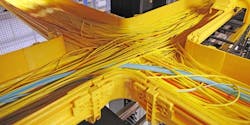Equinix: Enterprises Will Drive Huge Growth in Interconnection Data Traffic
Data centers will become even more pivotal to the digital economy over the next five years, which will see a meteoric rise in the volume of data traffic flowing through network intersections, according to a new report from Equinix.
Equinix is in a unique position to offer a global perspective on traffic exchange, as it operates more than 200 data centers in 50 cities around the worlds. The company’s third Global Interconnection Index (GXI) projects that global interconnection bandwidth will grow at a 51 percent compound annual growth rate (CAGR) through 2025, to more than 13,300 Terabits per second (tbps). That’s equivalent to 53 zettabytes of data exchanged annually.
A growing volume of this traffic will come from enterprise IT operations, according to the GXI report, which included a survey of 2,450 senior IT professionals. Enterprise customers see interconnection as a key element of their digital business strategy, as they seek to manage growing data volumes and connect to more cloud platforms and business ecosystems.
“People, software and machines are creating and consuming data faster and in all the places where we work, play, and live,” said Rick Villars, Research Vice President, Datacenter & Cloud, IDC. “The significant increase in data created, aggregated and analyzed in these new locations is contributing to a major shift away from deploying IT in traditional corporate data centers.”
The impending tidal wave of data will need to be stored, moved and analyzed. Steve Madden, Vice President of Global Segment Marketing at Equinix, said the GXI data reveals “a seismic shift in all industries around the world: Businesses are moving their computing from centralized data centers to a hybrid infrastructure at the edge, creating, consuming and exchanging data faster and in more distributed locations than ever before.”
That’s why the data center industry is predicted to see strong demand in coming years, as global investors see a “compelling opportunity” in financing digital infrastructure.
As the world’s largest operator of interconnection facilities, Equinix is a logical champion for the value of interconnection. But it’s an opinion that is shared by investors and securities analysts, who increasingly see interconnection as a key competitive differentiator for colocation providers.
That opinion was reinforced in our recent Data Center Frontier Executive Roundtable (see “Key Trends in Interconnection, Cloud On-Ramps”), which highlighted the growing range of options employing software-defined networking (SDN) to manage connectivity.
Trends in the Data
So how much is 13.3 tbps of interconnection bandwidth? How do we get our heads around that number? “This is enough bandwidth to support every person on earth simultaneously downloading a complete season of Game of Thrones in ultra-high definition resolution in less than a single day,” said Equinix.
The GXI estimate of 2022 traffic is 7 percent higher than the projection in the 2018 report, meaning that actual usage is exceeding even the eye-popping projections for future data usage, prompting upward revisions in the data.
The largest interconnection growth will be in North America, followed by Asia and Europe. The largest percentage gain will be in Latin America.
As expected, telecom companies and cloud and IT service providers are expected to have the largest appetite for bandwidth, followed by the financial sector and manufacturing.
The report highlighted the growing importance of edge computing and delivering applications with low latency.
“With both applications and networks becoming more distributed, enterprises today will continue to require a low-latency, interconnected architecture to securely connect end users with business-critical applications,” said Sachin Gupta, Senior VP for Product Management in Cosco’s Enterprise Networking Business.
The Urban Edge
Any discussion of edge raises the question of “which edge?” As we’ve noted in previous coverage at DCF, edge computing is not a single technology, but a phrase that describes several layers of infrastructure, some of which are refinements of existing models.
Equinix has always focused on the core of the Internet, building clusters of data centers around major network intersections like Northern Virginia, Silicon Valley, Chicago and Dallas. In a discussion with DCF earlier this year, Madden noted that 12 global metros account for 90 percent of Internet traffic. For Equinix, the prime directive is extending on-ramps and off-ramps to bring more traffic through these major hubs.
In recent years, Equinix has begun to build in new markets where it is seeing data growth. Recent examples include data centers in Oman, Bulgaria, South Korea and Hamburg, Germany.
An emerging group of startups content that edge data centers will be part of a fundamental shift in Internet architecture, moving network interconnection points from the core of the Internet to its outer perimeter. They envision a future in which thousands of small data centers provide multi-tenant colocation services at stadiums, urban rooftops and telecom towers. That includes peering and interconnection, which would mean rethinking a core principle of interconnection, which has historically focused on the densest concentrations of networks.
What’s clear is that there will be plenty of data, which will need to be stored and managed. For those tracking trends in data growth, the GXI joins the Cisco Visual Networking Index as a useful source of data points to provide context on the road ahead.
About the Author



